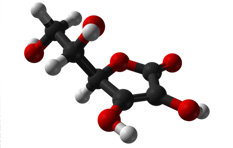







Vitamin C molecule
Introduction
l-Ascorbic Acid (vitamin C, AsA), obtained from citrus fruits and leafy green vegetables, is a water soluble vitamin and naturally occurring antioxidant.
There is an increasing awareness that vitamin C has a wide variety of roles in human health, and thus it has been studied by various researchers. New therapeutic uses are being investigated daily, and recent discoveries show that vitamin C can play important role in the health and beauty of skin.
Mode of Action
Vitamin C in the ascorbyl form has been tested extensively and is reported to interfere with pigment synthesis at various oxidative steps of melanin production. It causes skin lightening by interacting with copper ions at the tyrosinase active site and by reducing oxidized dopaquinone, a substrate in the melanin synthetic pathway and interrupting DHICA oxidation It also acts as an ROS scavenger by donating electrons to neutralize free radicals found in the aqueous compartment of the cell.
In addition to skin lightening, other advantages of Vitamin C include not only antioxidant effects but some studies also demonstrate anti-inflammatory and photoprotective properties.
Formulations
Ascorbic acidis typically used in 5 to 10% concentrations and can be formulated with other depigmenting agents, such as hydroquinone.
Safety
It is generally well tolerated in skin of color given the good safety profile of ascorbic acid. Ascorbic acid and its derivatives have been shown to be safe with some efficacy in certain racial/ethnic populations including Latino and Asian patients for the treatment of melisma.
Disadvantages
One of the disadvantages of Vitamin C is its chemical instability in aqueous solution and its tendency to rapidly oxidize and denature in aquenous solutions. The hydrophilic nature of AsA also limits its skin penetration, unless the stratum corneum barrier is disrupted so esterified derivatives, such as ascorbyl-6-palmitate and magnesium ascorbyl phosphate, were created.
>
>
>
>
>
>
>
>
>
>
>
>
>
>
>
>
>
>
>
>
>
>
>
>
>
>
>
>
>
>
>
>
>
>
>
>
>
>
>
>
>
>
>
>
>
>
>
>
>
>
>
TOP 20
Hydroquinone
Monobenzyl Ether of Hydroquinone
Azelaic Acid
Kojic Acid
Arbutin
Retinoids
Mequinol
Niacinamide
Soy
Vitamin C
Corticosteroids
Licorice
Hydroxystilbene
Aloesin
Glutathione
Glycolic Acid
N Acetyl Glucosamine
Gentisic Acid
Green Tea
Melatonin
SKIN WHITENING AGENTS A-Z
a-Hydroxyacids
Aloesin
Alpha Tocopherol and Alpha Tocopherol Ferulate
Arbutin
Azelaic Acid
Centaureidin and Methylophiopogonanone B
Gallic Acid and Derivatives
Gingko
Ginseng
Glutathione
Glycolic Acid
Green Tea
Hesperidin
Hydroquinone
Hydroxycinnamic Acid and Derivatives
Hydroxystilbene
Kojic Acid
Licorice
Linoleic Acid
Magnesium Ascorbyl Phosphate
Melatonin
Mequinol
Monobenzyl Ether of Hydroquinone
Mulberry
N Acetyl Glucosamine
N-Acetyl-4-S-Cysteminylphenol
Niacinamide
Retinoids
Salicylic Acid
Soy
Vitamin C

<< Previous: Soy